

Shane O'Donoghue
2025 Nissan Ariya Nismo review: Quick drive
6 Days Ago
The large luxury sedan segment may be in decline but along comes Genesis with a new generation of G80, boasting a new platform, new engines and new technology.
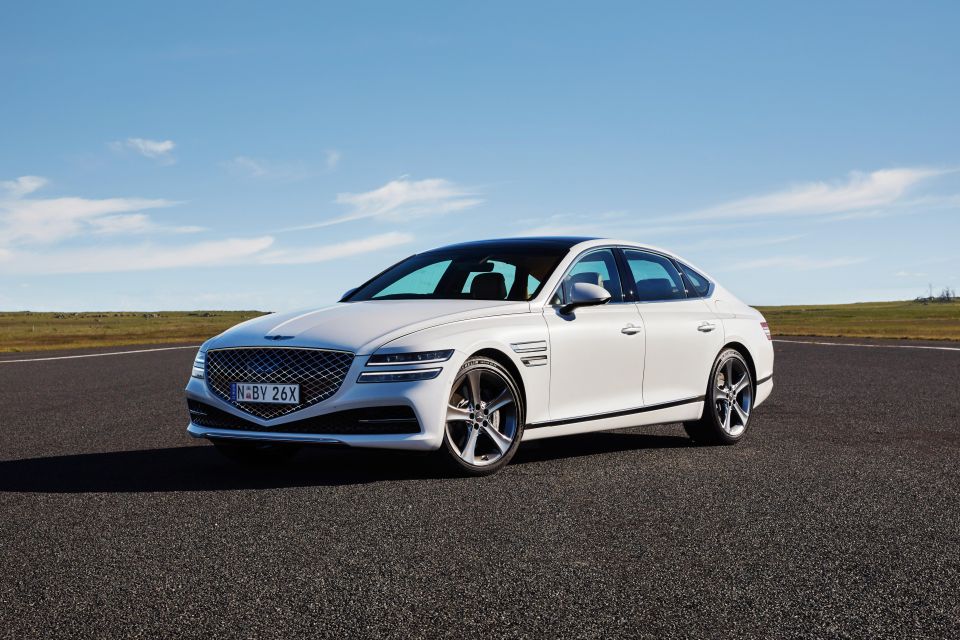


News Editor
New from
$68,900
excl. on-roads

News Editor
New from
$68,900
excl. on-roads


News Editor
New from
$68,900
excl. on-roads

News Editor
New from
$68,900
excl. on-roads
Quickly see how this car stacks up against its competition. Select any benchmark to see more details.
Where expert car reviews meet expert car buying – CarExpert gives you trusted advice, personalised service and real savings on your next new car.
If you’re looking for a bustling segment on the Australian market, the large luxury sedan segment probably isn’t it.
The Infiniti Q70, Lexus GS, and Volvo S90 have all been discontinued, while the Jaguar XF range has been pared back to a single variant. And yet here comes Genesis with a second generation of its G80, based on the same ‘M3’ architecture as the new GV80 SUV that’ll surely outsell it.

Since its launch just over 12 months ago, Genesis has offered only the G70 and first-generation G80 sedans. The latter had previously been sold through Hyundai showrooms as the Hyundai Genesis, the second global generation of that nameplate but the first to be sold here.
Not to sound like the lead in a 1980s action movie but: this time, it’s personal. I own a 2015 Hyundai Genesis Ultimate, which but for the addition of adaptive suspension and some other minor tweaks, is fundamentally the same as the outgoing G80. That means I’ve had extensive seat time in this new car’s predecessor.
First impressions are good. The outgoing car was a sharp looker, with almost exaggerated long bonnet/short deck rear-wheel drive proportions.
The new car features a more overtly crest-shaped grille, while its fastback silhouette is even sleeker than before. It’s 15mm lower than the outgoing car but 35mm wider and 5mm longer, riding the same 3010mm wheelbase despite moving to a new ‘M3’ platform shared with the GV80.
The brand’s ‘Quad Lamp lighting’ elements are present and accounted for up front and mirrored by the side indicators and tail lights. It’s instantly recognisable as a Genesis, once you’re aware aware what a Genesis is, and it’s sleek and elegant without looking overtly sporty. Overall, it’s a little more Audi A7 than Audi A6.
Perhaps the most polarising aspect of the exterior design are the wheels. While the flagship 3.5T wears conventionally-styled and quite handsome 20-inch alloy wheels, the 2.5T wears 19-inch alloy wheels that we’ve heard alternately referred to as “lace doilies” and “quasi-BBS alloys”.
They grow on you and their diamond pattern resembles that of the G80’s grille, but the 20-inch wheels are more likely to be crowd-pleasers.
Genesis is targeting younger buyers with the new G80, specifically buyers in their 40s and 50s. It’s also targeting private buyers, despite the old car’s appeal with hire car operators.
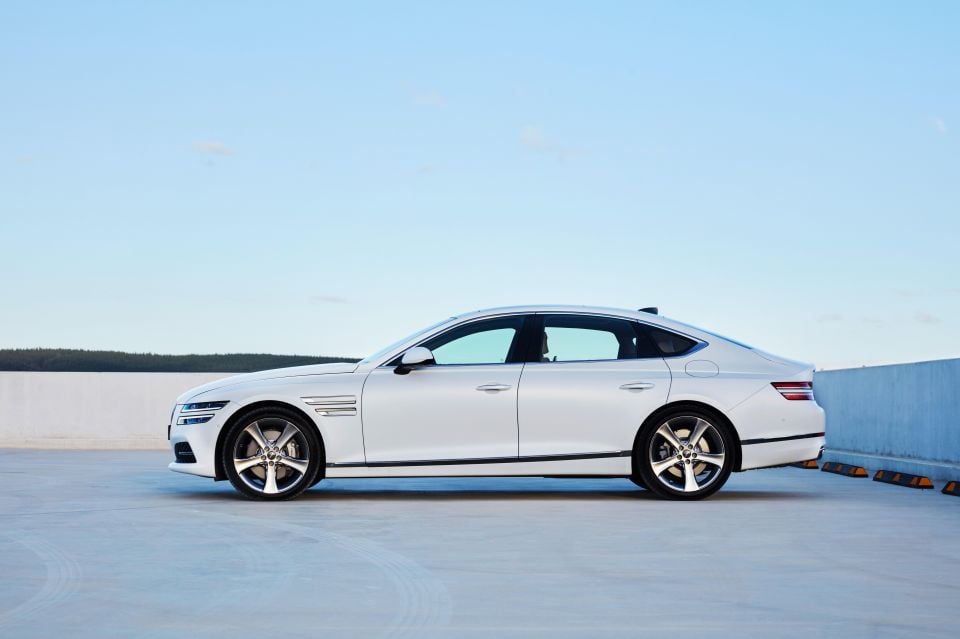
Genesis is bringing just two G80 variants to Australia, both of which are available with a $13,000 Luxury Package the company thinks will be chosen by around half of all buyers.
The rear-wheel drive 2.5T is priced at $84,900 before on-road costs, while the all-wheel drive 3.5T is $99,900 before on-roads.
While that base price is $16,000 higher than last year’s model, the 2.5T’s spec levels are closer to that of the outgoing G80 Ultimate that was priced at $88,900 list.
Genesis claims it’s 15 per cent better value than rivals like the Mercedes-Benz E-Class and BMW 5 Series in terms of pricing, and 20 per cent better value when looking at equipment. The company expects sales to initially skew more towards the 3.5T, though ultimately it believes the 2.5T will account for 55 per cent of sales.
If you’re concerned about depreciation – this is a relatively unknown brand, after all – Genesis is working on introducing a guaranteed future value program, though it hasn’t confirmed any details yet.
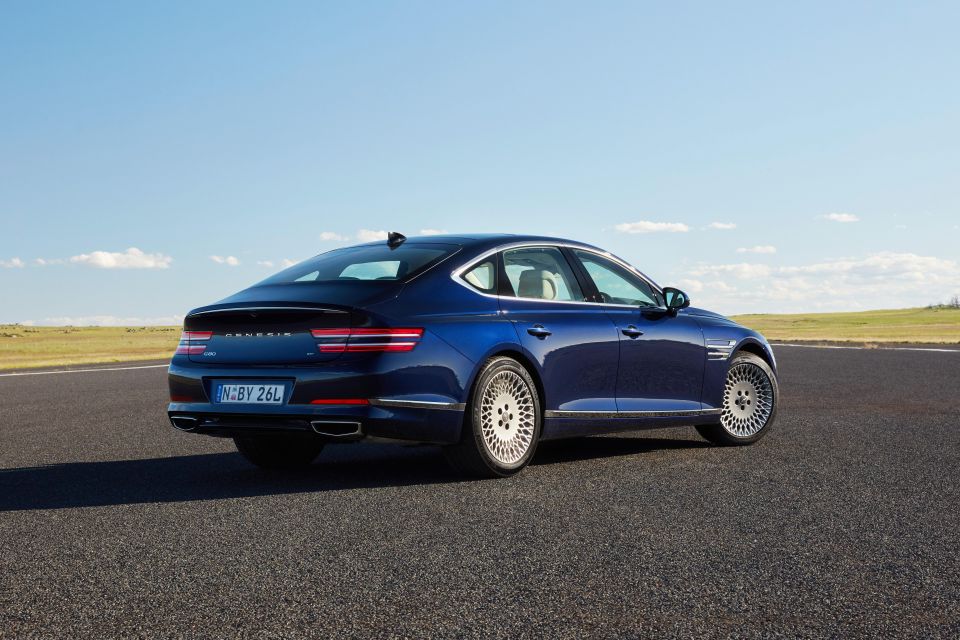
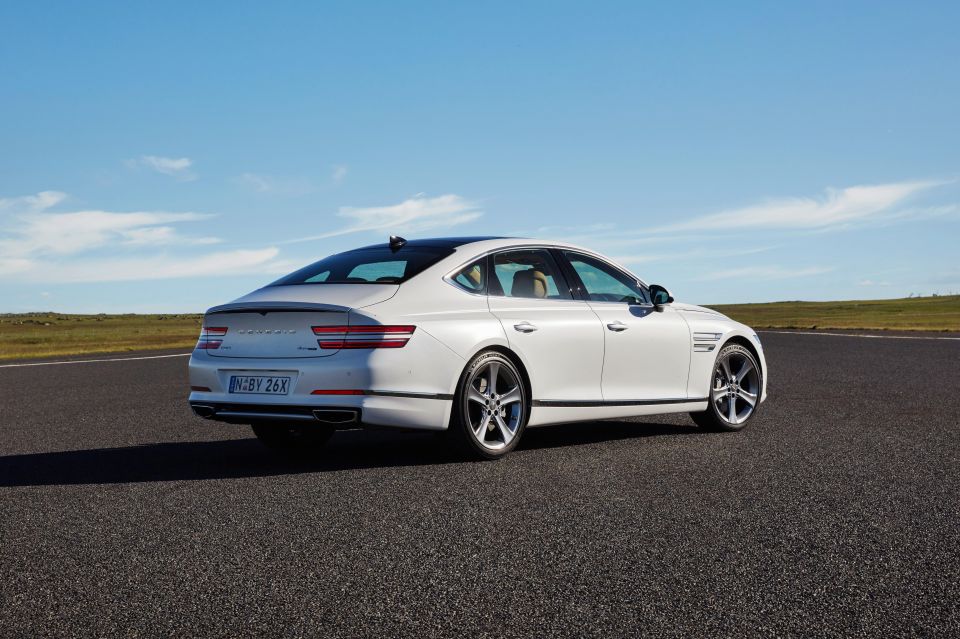
Settle in, this is going to take a while.
Both models effectively have the same level of trim, with the 3.5T differing only in adding adaptive suspension and 20-inch alloy wheels wrapped in Michelin Pilot Sport 4S tyres (instead of 19-inches and Michelin Pilot Sport 4 tyres).
That means both models come standard with remote start, a power hands-free boot lid, adaptive LED headlights, adaptive cruise control with stop/go, a surround-view camera, and keyless entry and start.
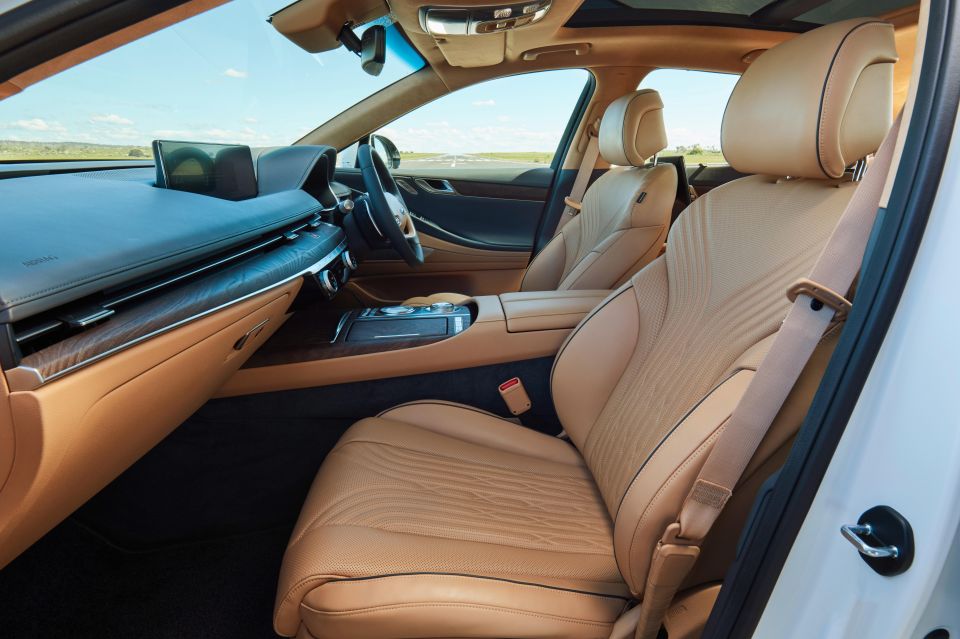
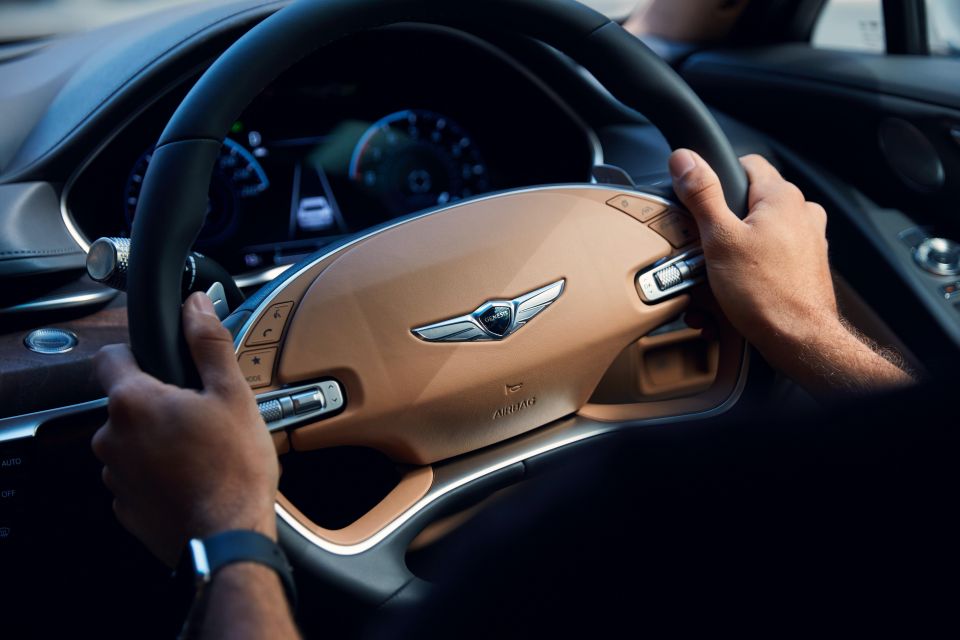

Inside, there’s leather trim on the seats, doors, dash and centre console, as well as real open-pore wood trim, a panoramic sunroof, heated and ventilated front seats, dual-zone climate control with temperature controls front and rear, as well as 12-way power-adjustable, heated and ventilated front seats with driver’s memory and four-way lumbar.
Both models have a 14.5-inch touchscreen infotainment system with Android Auto, wireless Apple CarPlay, DAB+ digital radio and satellite navigation boasting an augmented reality function, plus a 12.0-inch head-up display, wireless phone charging, and a 21-speaker, 1050W Lexicon by Harman premium sound system. That sound system also includes a sub-woofer under each front seat.
If that’s not enough kit, the $13,000 Luxury Package is the only option besides matte paint, which is $2000. It lumps a wide array of tech and luxury features plus a couple of safety features, too.
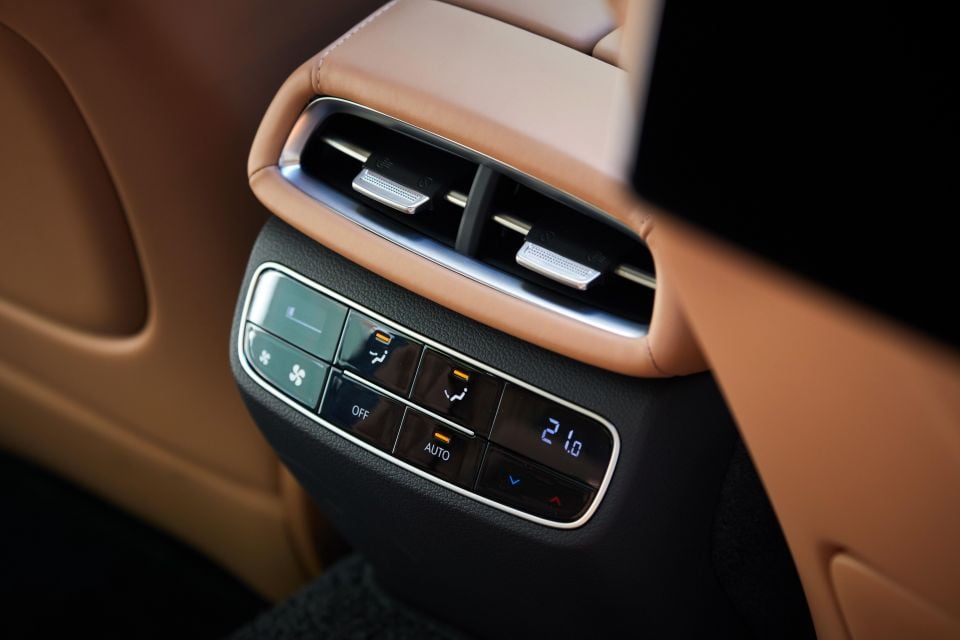
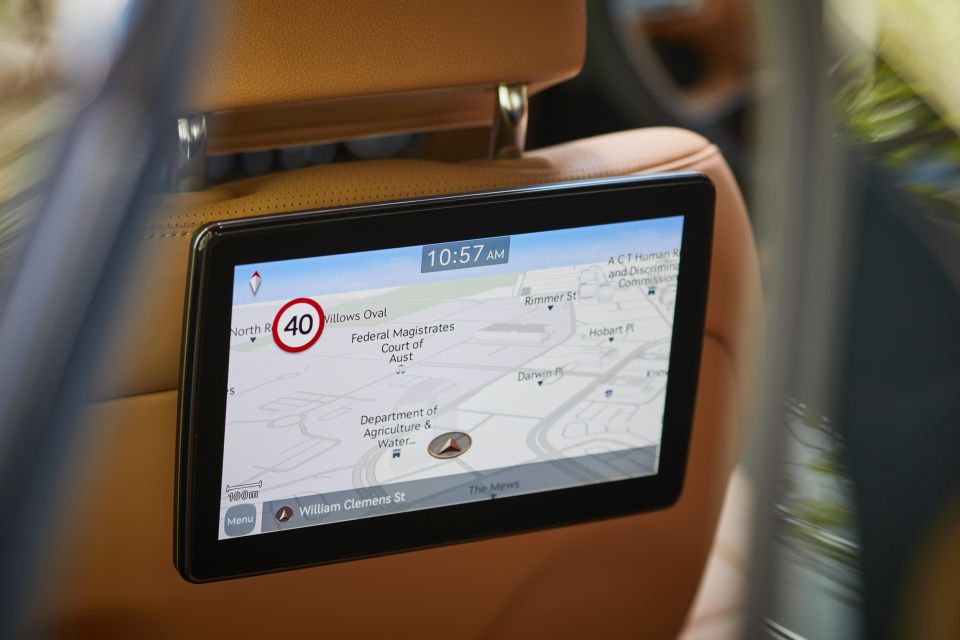
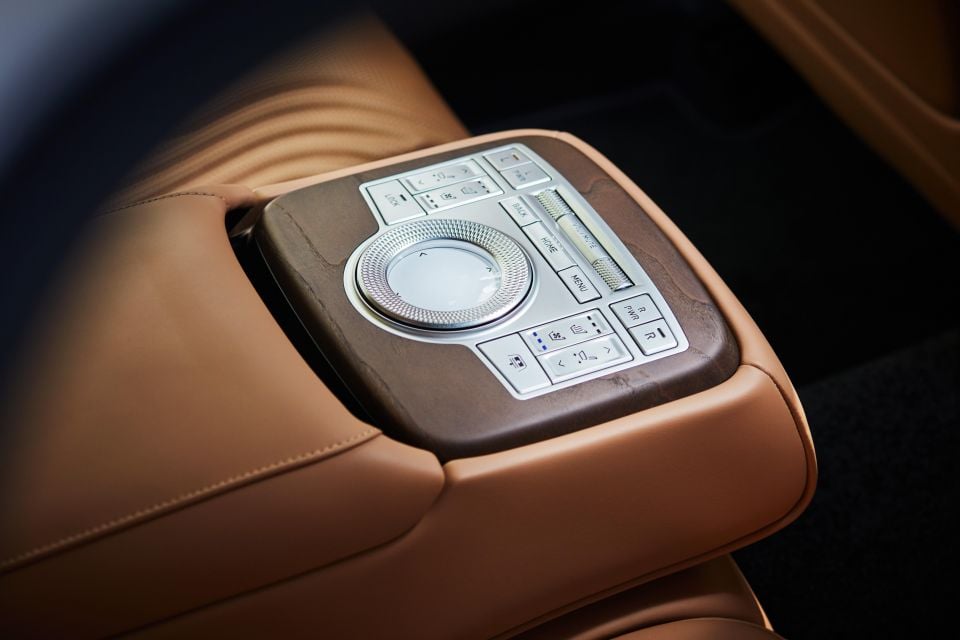
Luxury mod-cons include heated, ventilated and power-adjustable outboard rear seats, suede headliner and pillars, quilted Nappa leather upholstery, tri-zone climate control, soft-close doors, an 18-way power driver’s seat with massaging, and a power rear sunshade.
The package also adds Genesis’ Intelligent Front Lighting System with matrix LED technology, plus a 12.3-inch digital instrument cluster with 3D technology, and semi-autonomous and remote parking assist – you’ll know it from the commercial as Smahht Pahhk.
The Luxury Package is effectively the same as that on the GV80, though in the G80 it includes a rear-seat entertainment system with dual 9.2-inch touchscreens. It’s interesting that’s available on the G80 and not the GV80, considering we expect the latter to be more popular with families.
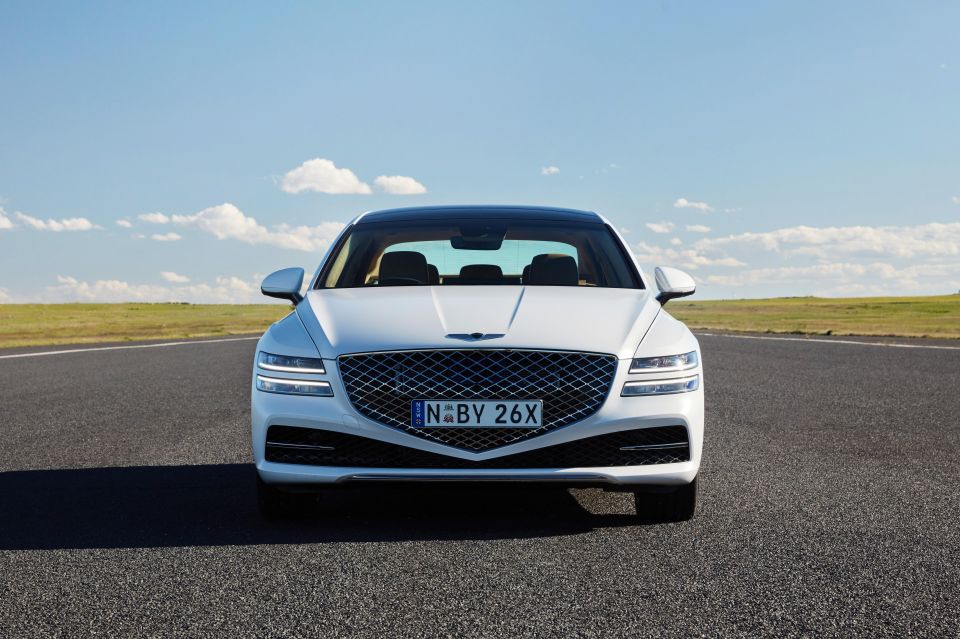
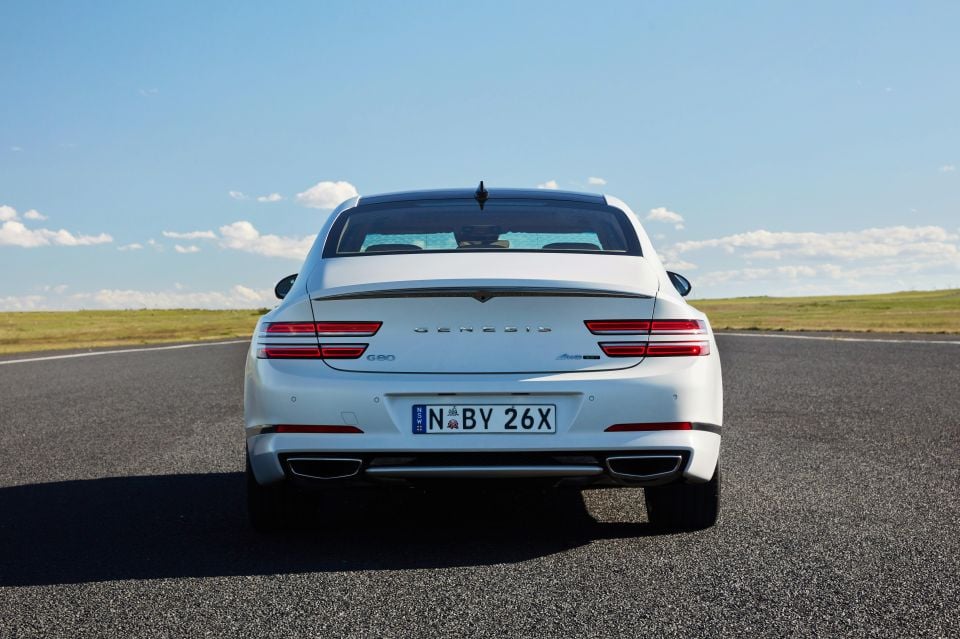
The G80 has yet to be tested by ANCAP or Euro NCAP, so we can’t answer that just yet.
Driver attention monitoring and reverse parking collision avoidance assist are unfortunately available only in the Luxury Package, but the list of standard safety kit is still impressively long.
It includes autonomous emergency braking with pedestrian and cyclist detection, evasive steering assist, junction turning and junction crossing functions, and lane-change oncoming and side functions.
There’s also blind-spot monitoring with side/rear collision avoidance assist, lane-keeping assist, lane-following assist, rear cross-traffic alert and collision avoidance assist, rear occupant alert, safe exit warning, an active bonnet, and 10 airbags including one between the two front occupants.
We especially like the idea of the rear occupant alert, which will beep the horn if it detects motion in the back for up to eight hours after you switch off the car.
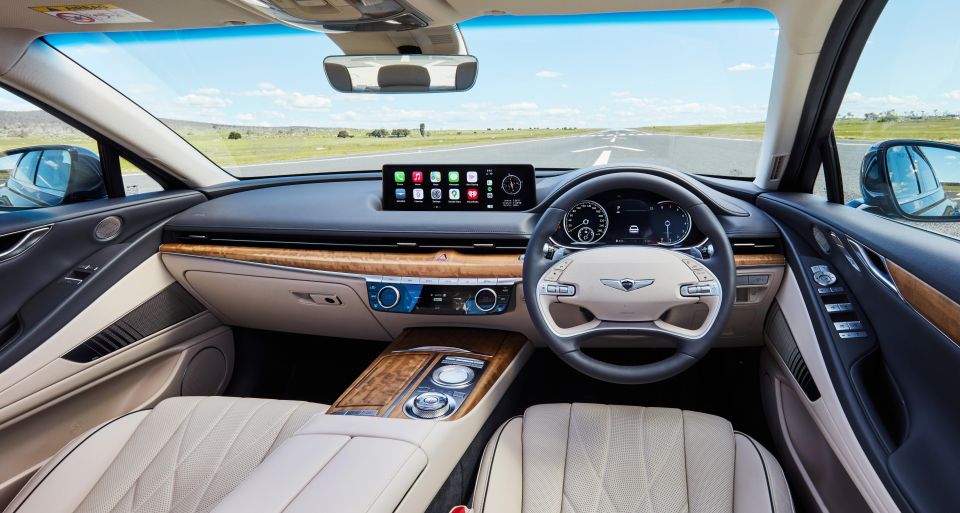
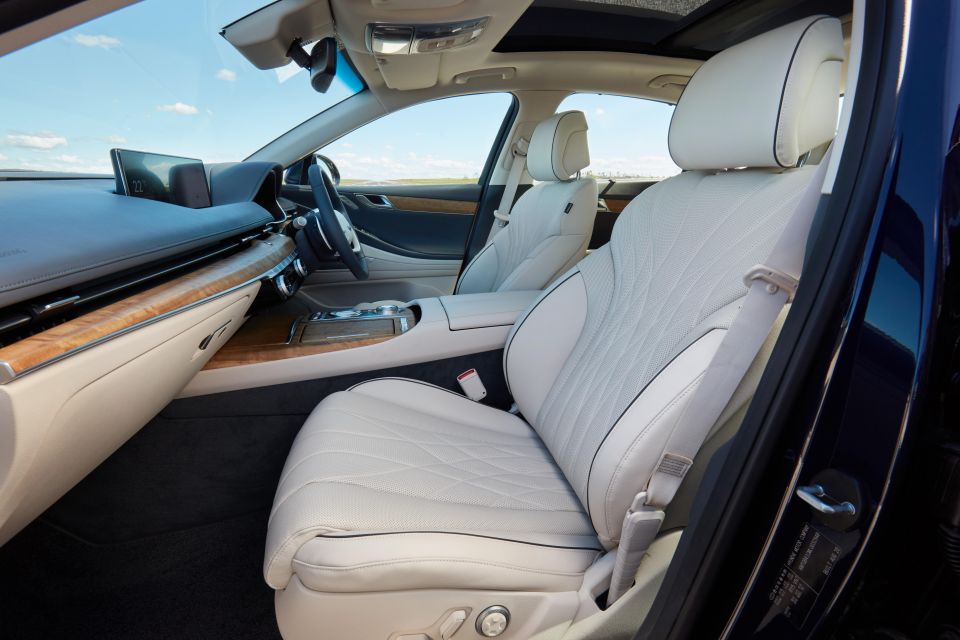
If you like the GV80’s interior, you’ll like the G80’s. The overall design is similar, though the centre console is naturally lower in the sedan, while the wood trim across the dash is even more prominent. There are a few different two-tone colourways available as in the GV80, though the gorgeous Havana Brown and Forest Blue is my personal favourite.
Genesis claims the dashboard draws inspiration from, among other things, suspension bridges. We’re not sure about that, but we do know this is an elegant interior swathed in leather, including hide on the dashboard and centre console. And anything that isn’t leather-wrapped in this cabin is covered in soft-touch plastics.
The company says it’s kept buttons and switches to a minimum, though there are still proper shortcut buttons for various functions in the infotainment system. You can adjust the climate control via a black glass touch-capacitive panel which has haptic feedback.
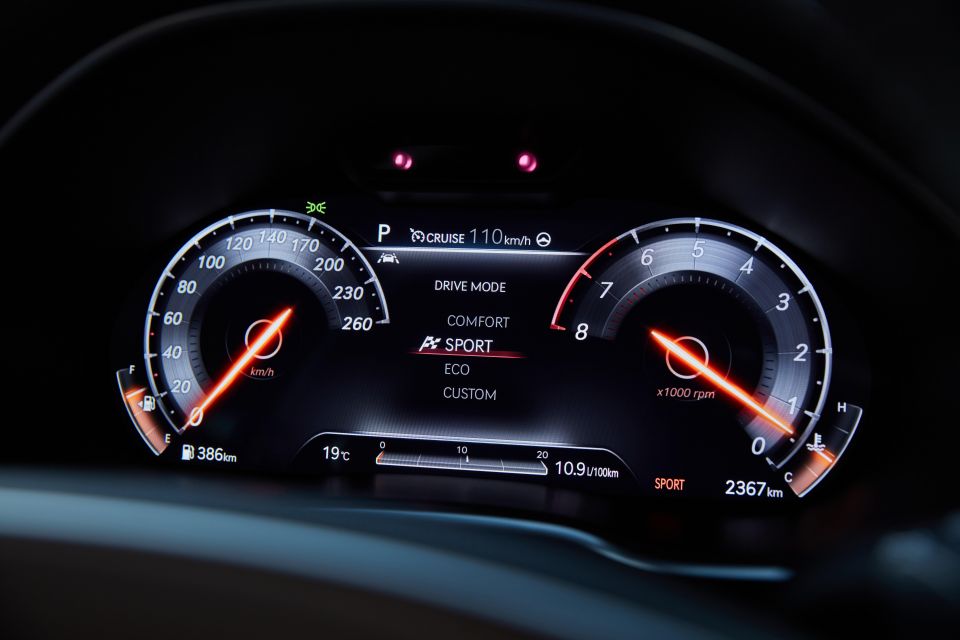
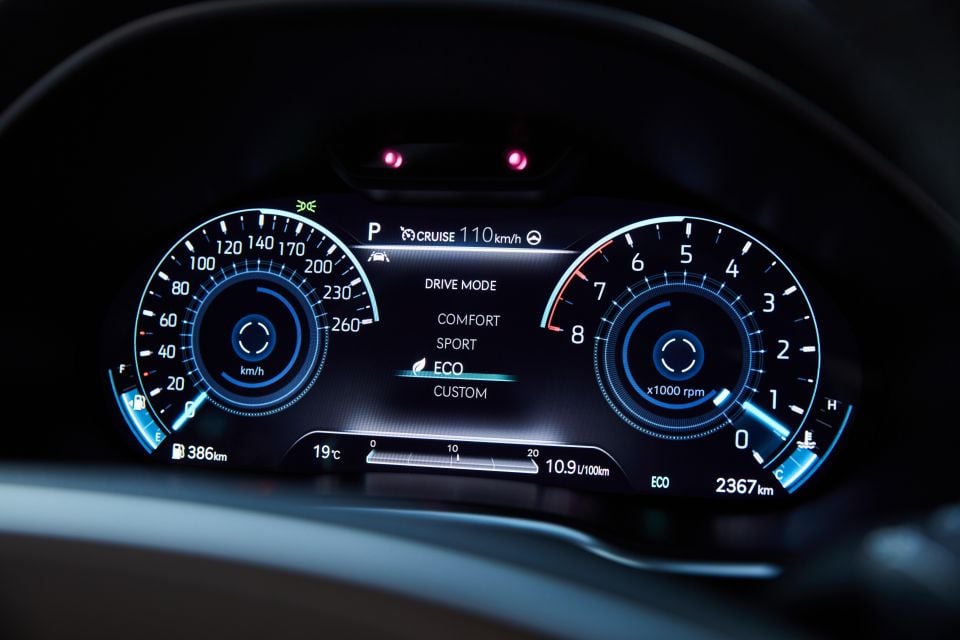
The Luxury Package’s digital instrument cluster may sound trippy with its stereoscopic 3D technology, but in execution it’s restrained and appropriately posh. It’ll also monitor the position of your eyes and sound a warning if you start closing your eyes too much or yawning too frequently.
The open-pore wood trim is gorgeous. While trim like this was available in the old car, it never made it to Australia so we were stuck with fake glossy stuff.
The ambience is also elevated with the addition of colour-adjustable ambient lighting, while you can also access a range of soundscapes through the infotainment system.
The old car’s cabin was lovely, with superb material quality and a very user-friendly design, but its infotainment system was effectively two generations old. Once again, Australia missed out on something available in other markets: an updated infotainment system with Apple CarPlay and Android Auto.
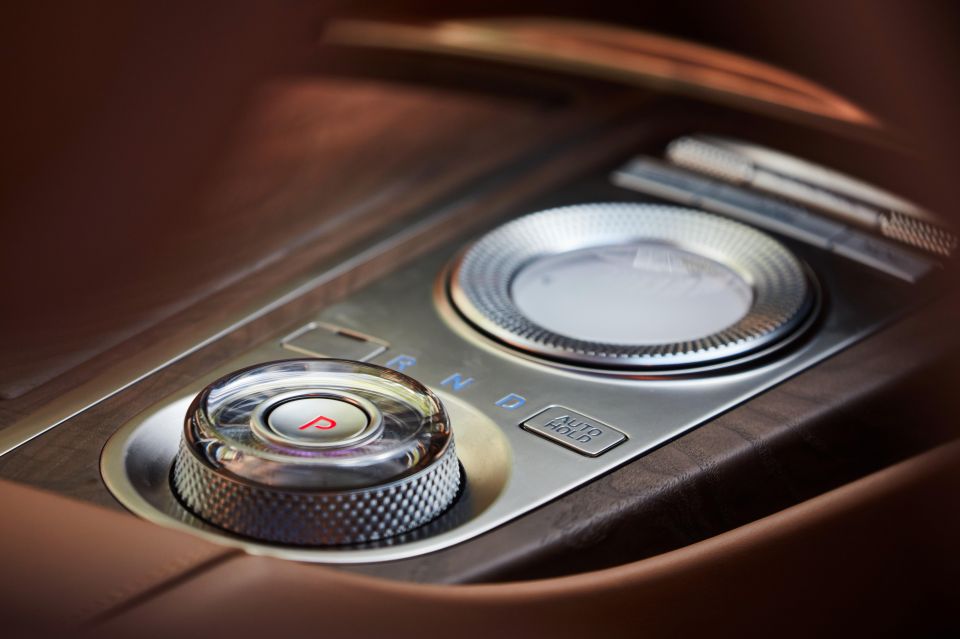
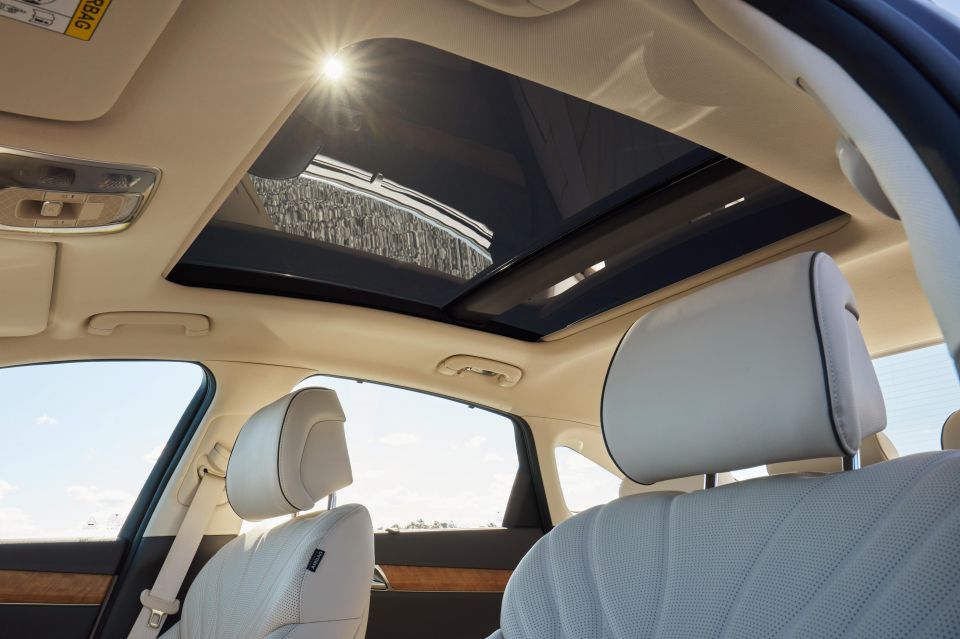
Fortunately, we’re now getting everything available in other markets, which includes a standard 14.5-inch infotainment system, controllable both by touch and via a dial near the rotary gear selector.
The tempered glass and metal dial also recognises handwriting inputs. Like much of the switchgear, it looks and feels appropriately premium.
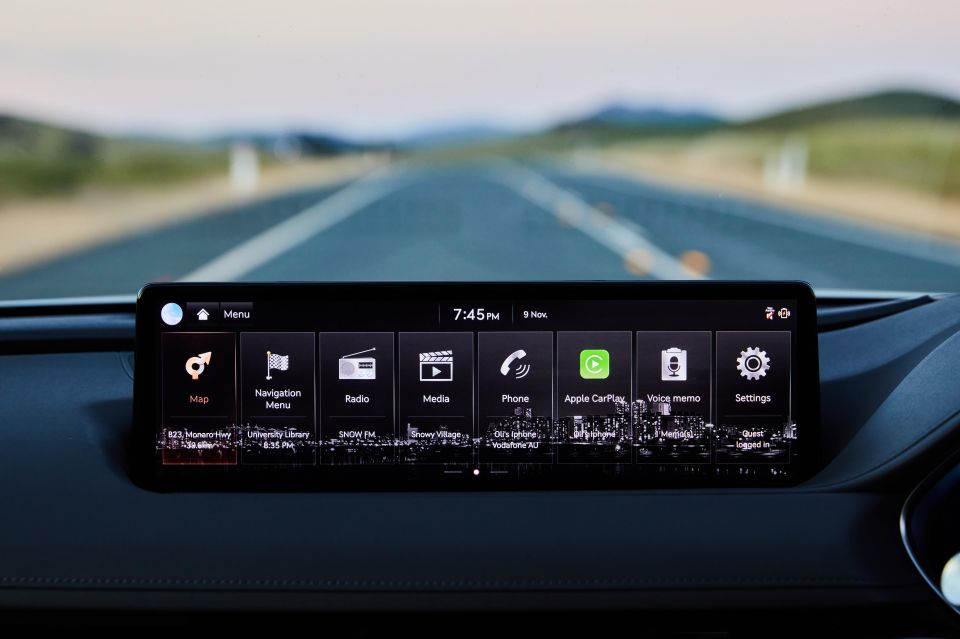
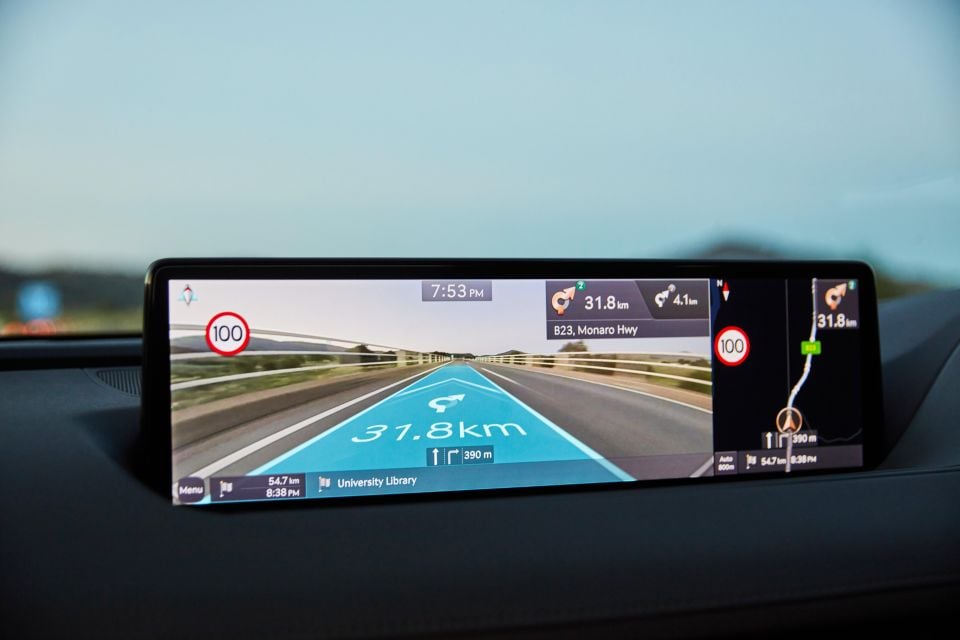
The infotainment’s user interface is new for Genesis, casting off the Hyundai UI used by first-generation Genesis models. It’s easy to use, responsive, and attractive.
The Luxury Package adds a massaging function for the driver’s seat but not the passenger’s which strikes us as unfair, especially because it’s a particularly good function. It’s activated via a button on the side of the seat, which will bring up the settings on the touchscreen.
It also adds adjustable bolsters which help hug you even tighter, though the standard 12-way power front seats are hardly church pews.


Though the sleeker roofline cuts headroom by 10mm, it’s by no means snug in the G80’s back seat despite its standard panoramic sunroof. Luggage space is down by 9L to 424L but, despite the G80’s fastback shape, it still has a fairly large opening.
About the only element of the interior that doesn’t look appropriate for the class is the base instrument cluster. It’s clear and legible and includes a trick blind-spot monitor camera view but it looks straight out of the Hyundai parts bin.
While we’re griping, some USB-C outlets would be appreciated, while, as in the old car, the ventilated seats could do with some more oomph.

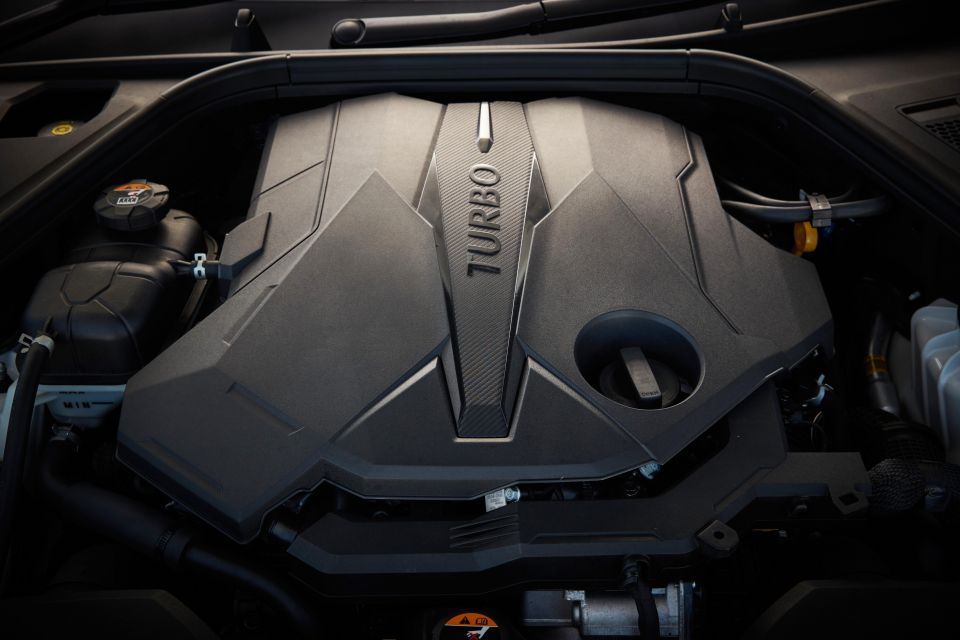
The outgoing G80 was available with a turbocharged 3.3-litre V6 and a naturally-aspirated 5.0-litre V8 in overseas markets, but it was sold here only with a naturally-aspirated 3.8-litre V6.
In contrast, the new car offers a choice of two boosted powerplants, with even the less powerful of the two producing 25Nm more torque, and lower in the rev range to boot. The base engine also has only 8kW less power than last year’s 3.8-litre.
The entry-level 2.5T is powered by a turbocharged 2.5-litre four-cylinder engine producing 224kW of power and 422Nm of torque. It’s rear-wheel drive, though an all-wheel drive version is available in other markets.
The all-wheel drive 3.5T uses a twin-turbocharged 3.5-litre V6 engine producing 279kW of power and 530Nm of torque. Again, there’s a rear-wheel drive version available in other markets but it’s off-limits to us.
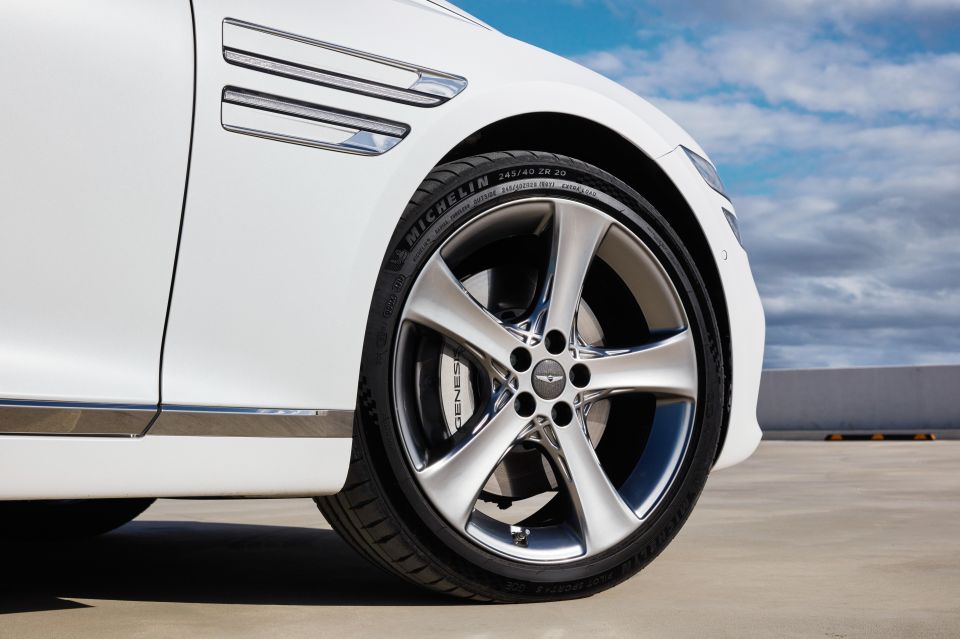
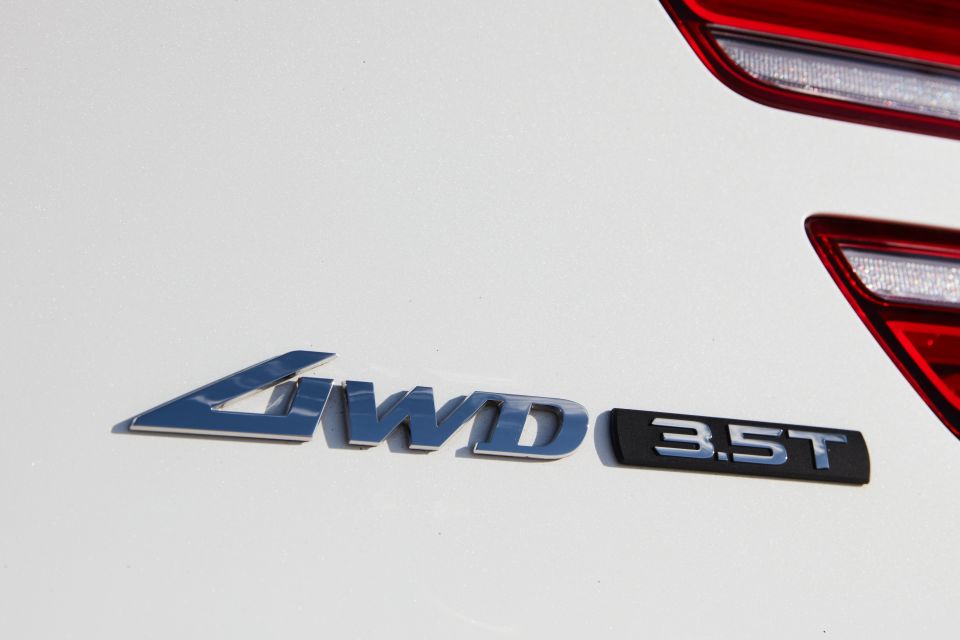
Where expert car reviews meet expert car buying – CarExpert gives you trusted advice, personalised service and real savings on your next new car.
Both engines are mated to an eight-speed torque converter automatic transmission, designed in-house. The 2.5T does the 0-100km/h dash in six seconds flat, while the 3.5T cuts that to 5.1 seconds. The old car took approximately 6.5 seconds.
There’s a diesel available in other markets but it’s not the impressive 3.0-litre inline-six turbo-diesel of the GV80. Instead, it’s a 2.2-litre turbo-diesel four-cylinder familiar from other Hyundai/Kia models.
Both the 2.5-litre and 3.5-litre are new for Genesis, as is the M3 architecture underpinning the G80 and GV80. Additionally, the rear-biased all-wheel drive system is new and features active torque control. It’ll send up to 90 per cent of power to the front wheels if it detects slippage, while switching to Sport mode sends more torque to the rear.
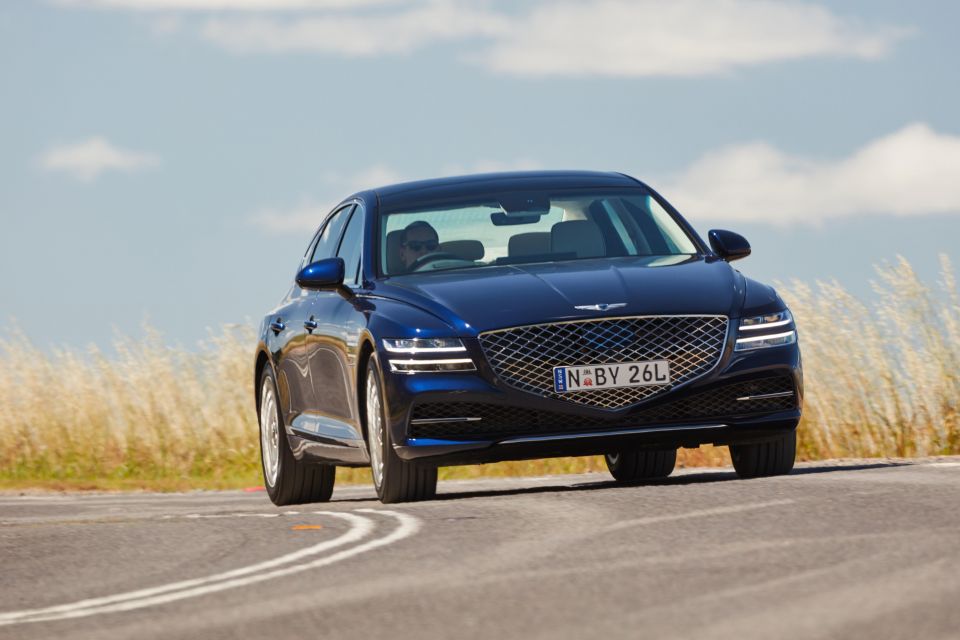
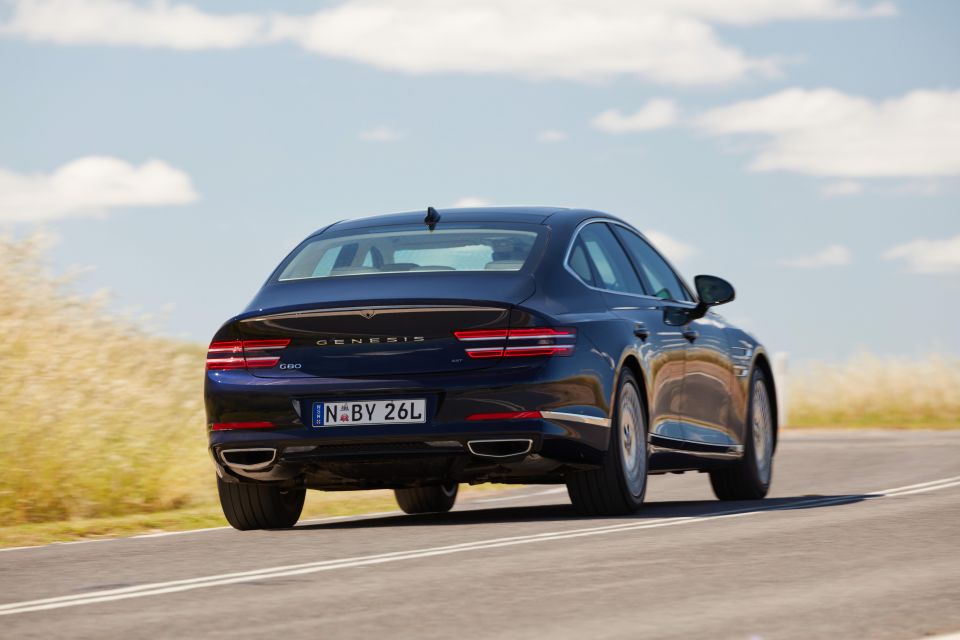
Driving the 2.5T and 3.5T back-to-back, one emerges as the clear favourite. Spoiler alert, it’s not the more expensive one.
The 2.5T may not sound quite as good as the 3.5T under full throttle – though both are muted – but it feels lighter and more nimble, with sharper turn-in.
The extra weight of the all-wheel drive system dulls the G80’s responses and the more powerful G80 exhibits some understeer as you head into a corner, while the G80’s focus on smooth, effortless power means the 3.5T doesn’t feel like a comparative rocketship.
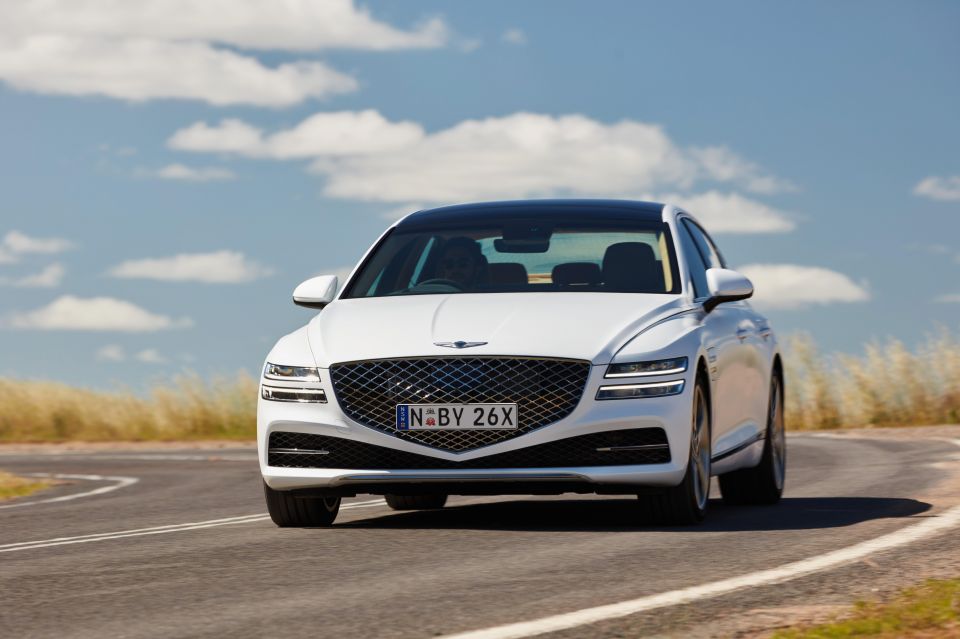
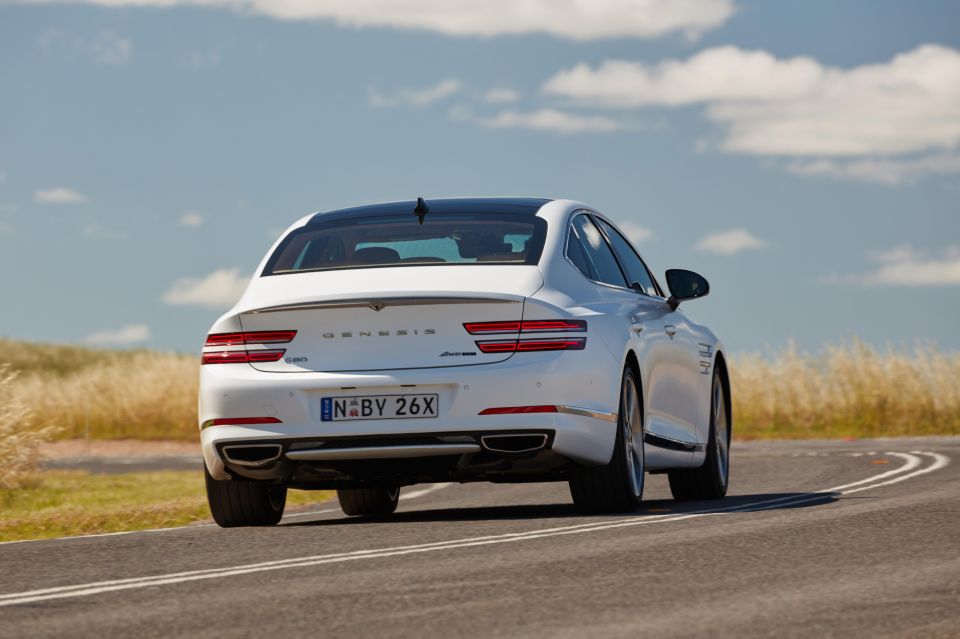
We’d love to see how a rear-wheel drive 3.5T feels, but unfortunately that model hasn’t been made available to us.
Both the 2.5T and 3.5T boast pliant ride quality, even over unsealed, flood-ravaged roads. The 3.5T’s adaptive suspension has brand-first Road Preview technology, which uses the front camera to scan the road ahead for potholes and speed bumps and adjusts the dampers accordingly.
Without adaptive suspension, the old car had a firm ride when equipped with 19-inch wheels. In the new car, ride quality is exemplary regardless of model or wheel choice.
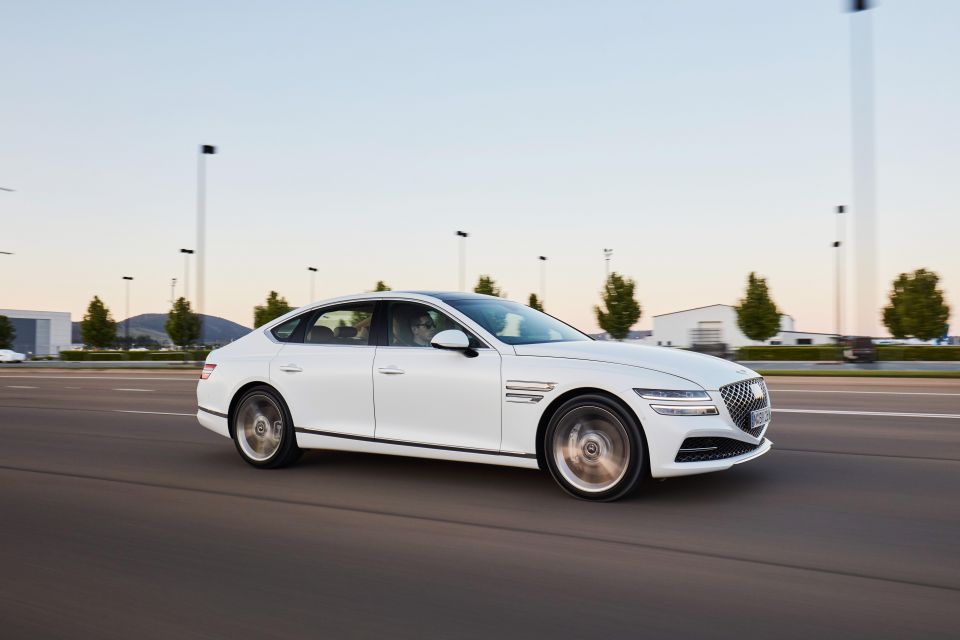
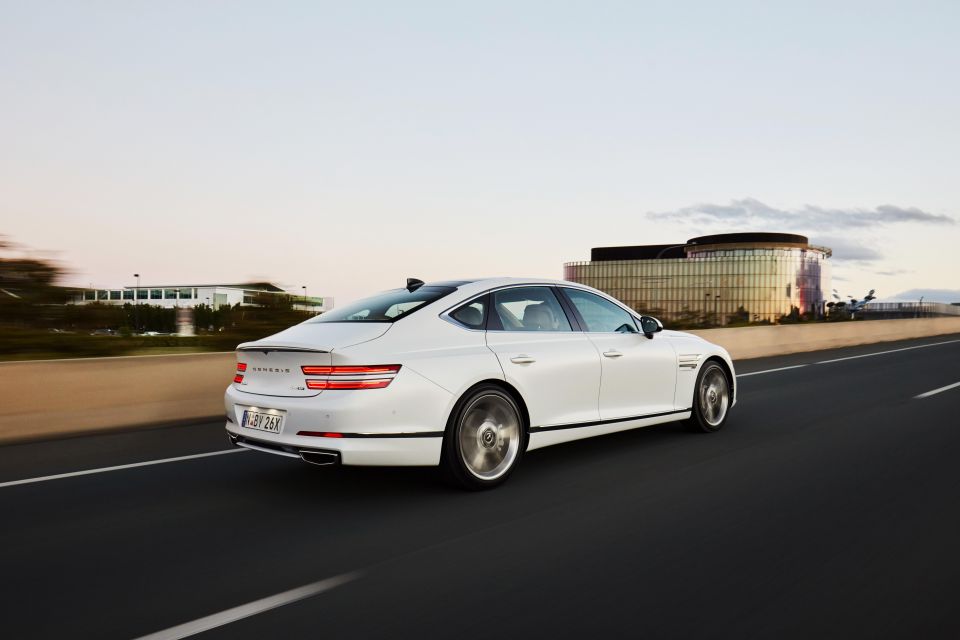
The 3.5T has too much suspension travel for our liking, however. We understand it’s not supposed to be stiffly-suspended, being a luxury sedan and all, but there’s a lot of vertical movement at high speeds.
Flicking it over to sport mode adjusts the dampers, among other things, but it doesn’t tie down the G80 enough. We’re fine with a cushy ride in Comfort mode if there’s a Sport mode that makes a noticeable difference, but the 3.5T’s Sport mode doesn’t quite make it.
Contrast that with the 2.5T’s passive suspension set-up. Instead of two modes that don’t quite strike the right balance, it has one setting that offers a pretty good mix of body control and ride quality. It’s not the athlete, say, a BMW 5 Series can be, but it’s nicely buttoned-down.
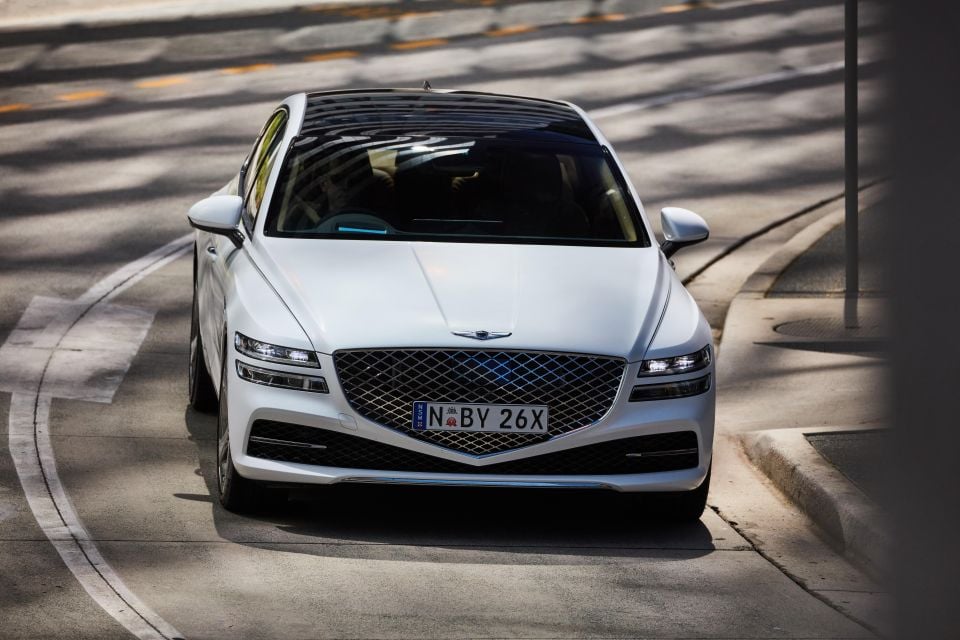

ESC calibration has been improved and power delivery is smooth, aided by the same refined, unobtrusive eight-speed automatic transmission developed in-house by Hyundai that we enjoyed in the GV80.
The steering is well-weighted and there’s a decent amount of road feel, while the controversial steering wheel feels good in your hands. Flicking to Sport mode adds a bit more artificial weight to the steering.
The interior is hushed, with road noise reduced through the use of triple door seals and acoustic glass for the windscreen and front doors. Luxury Package models add acoustic glass for the rear doors.
The safety systems all work well, particularly the G80’s blind-spot monitoring camera view in the instrument cluster. We did have some issues with an overly sensitive lane-departure warning alert, however, which went off even on roads without lane markings.
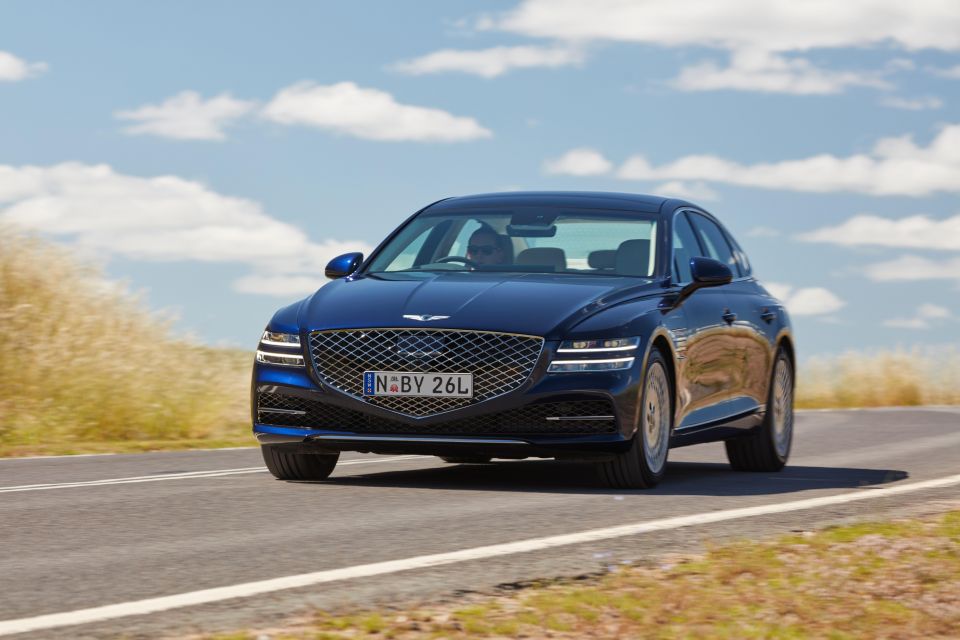
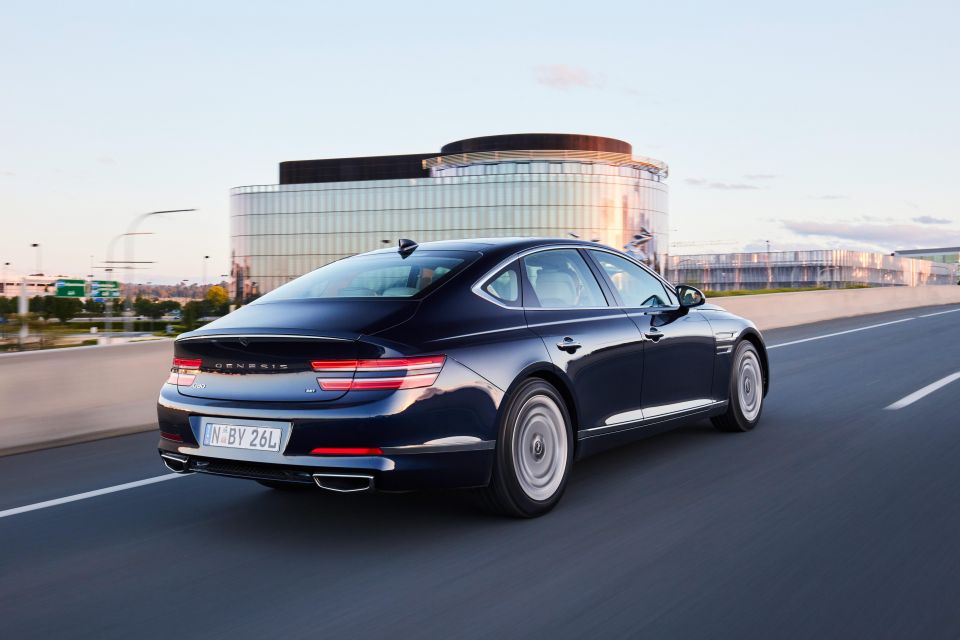
I’d like to take the new G80 to some of the mountain roads I’ve enjoyed many times in my Genesis. The outgoing car feels patrician around town but on some tight switchbacks, it can really hang in there.
Of the two new models, the 2.5T seems like it’ll come closest to that level of dynamic ability. The flip-side is it boasts a more comfortable ride than the old car, which is likely of far greater importance to potential buyers.
Genesis is referring to the G80 as a luxury sedan, in contrast with the G70 which it calls a sports sedan. That’s very clear in the overall dynamics of this larger model, which is on the softer end of the spectrum for this class. It doesn’t feel especially sportier or more poised than a GV80 and we’re not sure whether that says more about the G80 or the GV80.
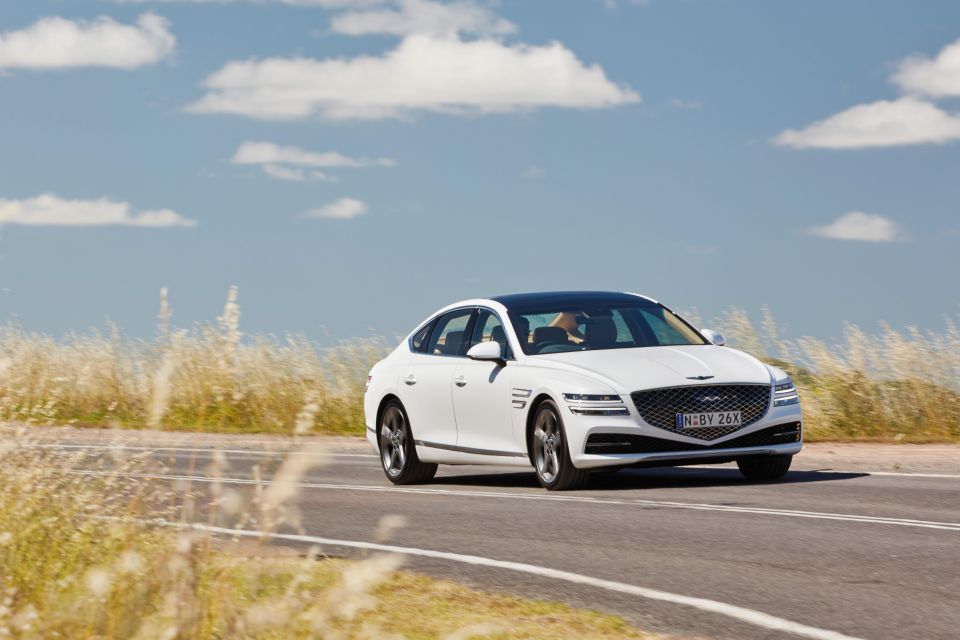
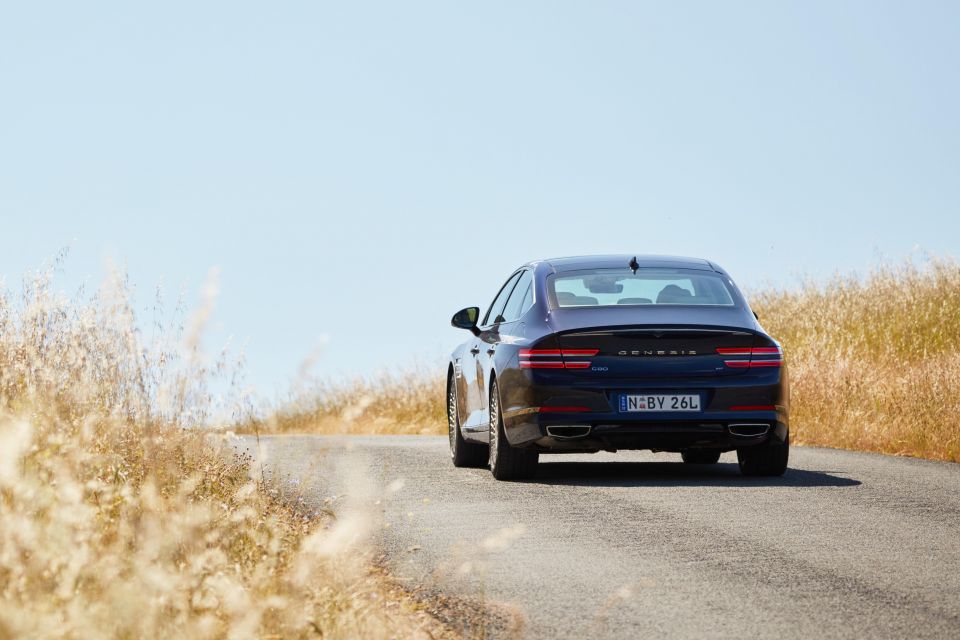
The company offered a Sport version of the old car in markets like the US. As Genesis has said all models bar its BMW 7 Series-rivalling G90 will be engineered for right-hand drive, we expect the inevitable Sport version of the new G80 to make its way here.
Now that a twin-turbo engine is available in the regular G80, it’s any guess what modifications will be made to the G80 to turn it into a G80 Sport but we suspect it’ll run a firmer suspension tune at the very least.
Genesis offers perhaps the most generous after-sales package in the luxury car market. There’s five years or 50,000km of free scheduled servicing (intervals are 12 months/10,000km), a five-year unlimited kilometre warranty and five years of 24/7 roadside assistance.
Genesis also includes a concierge service where it will pick up your G80 for scheduled servicing and leave you with a Genesis courtesy vehicle.
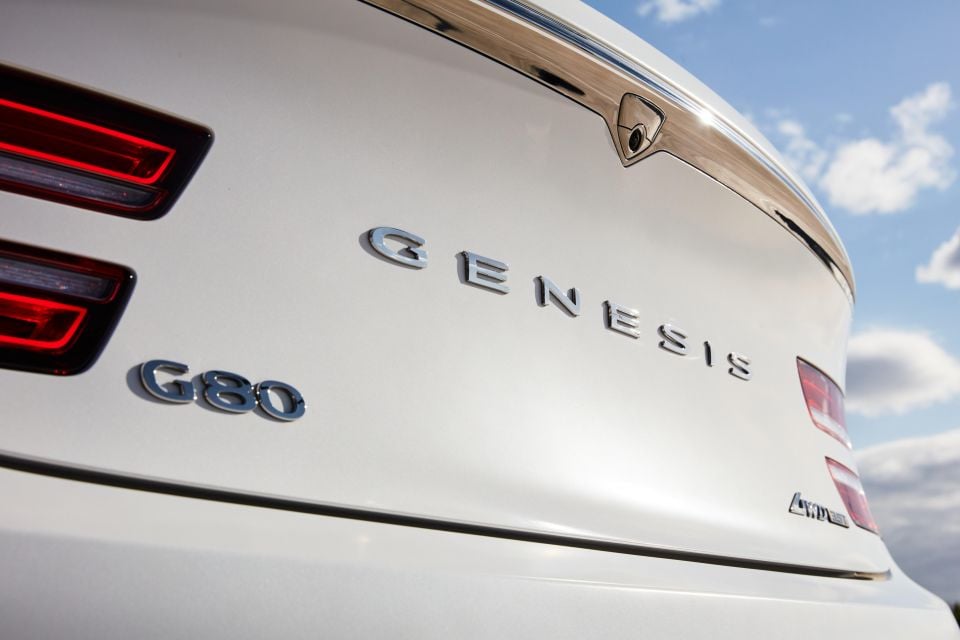

The 2.5T uses 8.6L/100km in the 2.5T while the 3.5T uses 10.7L/100km, both on 95RON premium unleaded fuel. The old car, which was slower than both, used 10.8L/100km though, unusually for the segment, it needed only 91RON regular unleaded instead of 95RON.
While the G80 is more efficient than before, it’s still not quite as parsimonious as rivals like the BMW 520i and 530i or Mercedes-Benz E200 and E300.
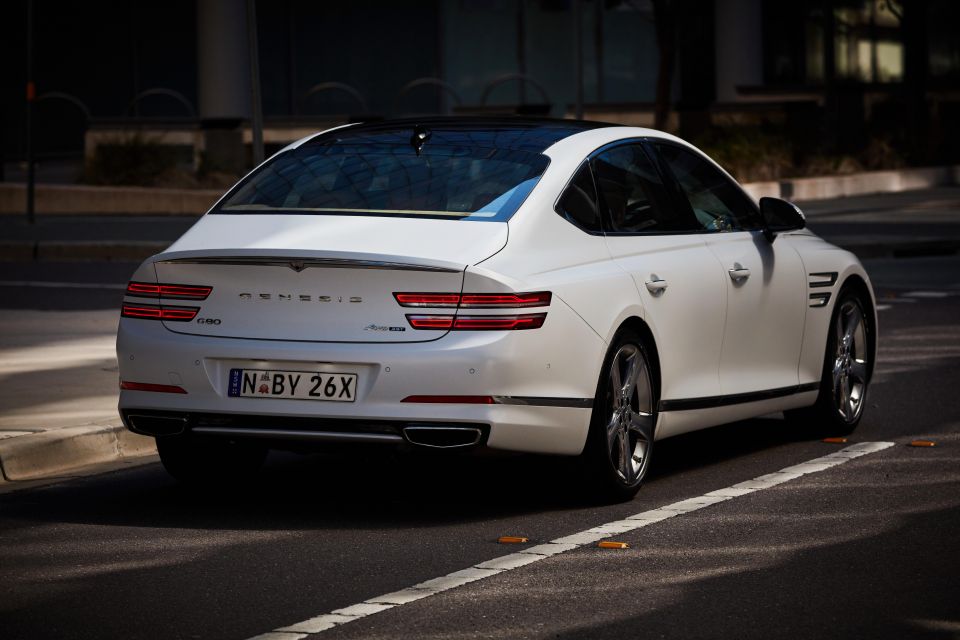
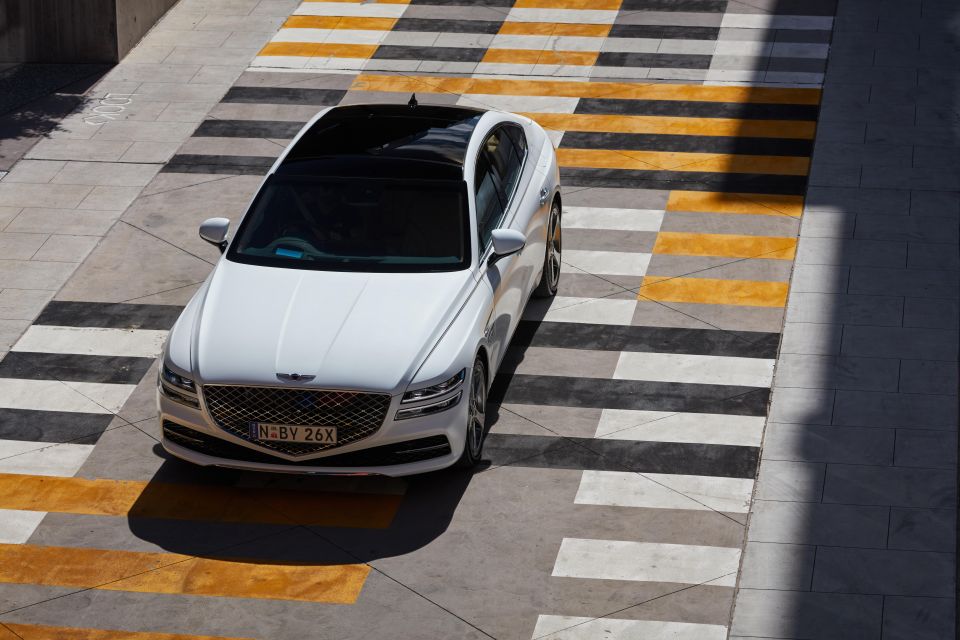
The G80 sits on the soft and comfier end of the large luxury sedan spectrum and it cossets with aplomb. It offers a pliant ride and a hushed cabin, wrapped in upscale exterior styling and finished with an elegant interior featuring excellent craftsmanship.
We admire the simplicity of the model line-up, especially considering this will be a low-volume model in a declining segment.
But Genesis’ introduction of the all-wheel drive 3.5T instead of the rear-wheel drive model is a bit puzzling, considering most rivals are rear-wheel drive; it’s reminiscent of Jaguar’s head-scratching decision to switch exclusively to an all-wheel drive XF with that car’s mid-cycle update.
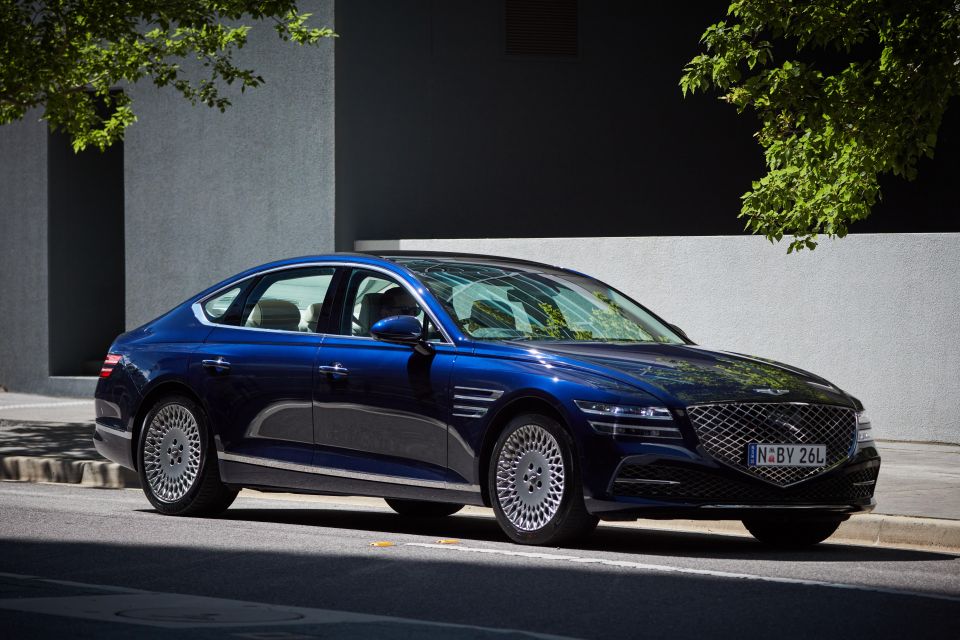

In terms of its interior, the new G80 has taken a step up. The open-pore wood trim is gorgeous, the colourways distinctive and the in-car technology – particularly the infotainment system – is miles ahead of its predecessor. Any traces of Hyundai parts inside have been further banished, but for the disappointing base instrument cluster.
The new engines are a welcome replacement for the old car’s lusty but thirsty 3.8-litre V6, and both are smooth, effortless and matched to an excellent transmission. We’re just not sure the 3.5T is worth the extra expense. The base engine is plenty punchy, while its passive suspension strikes a better balance of ride quality and body control.
The G80 doesn’t feel much more fun to drive than the GV80 SUV and, in fact, it feels a little cushier. But that’s the G80’s mission, it would appear – to be the brand’s (local) flagship luxury sedan, offering a sybaritic interior and driving manners. If you’re looking for a harder-edged sports sedan, this isn’t your car. If a plush ride and a serene cabin are what you’re after, put this on your list.
Where expert car reviews meet expert car buying – CarExpert gives you trusted advice, personalised service and real savings on your next new car.
William Stopford is an automotive journalist based in Brisbane, Australia. William is a Business/Journalism graduate from the Queensland University of Technology who loves to travel, briefly lived in the US, and has a particular interest in the American car industry.


Shane O'Donoghue
6 Days Ago


Anthony Crawford
5 Days Ago


Matt Campbell
4 Days Ago


James Wong
3 Days Ago


Max Davies
1 Day Ago


Josh Nevett
13 Hours Ago